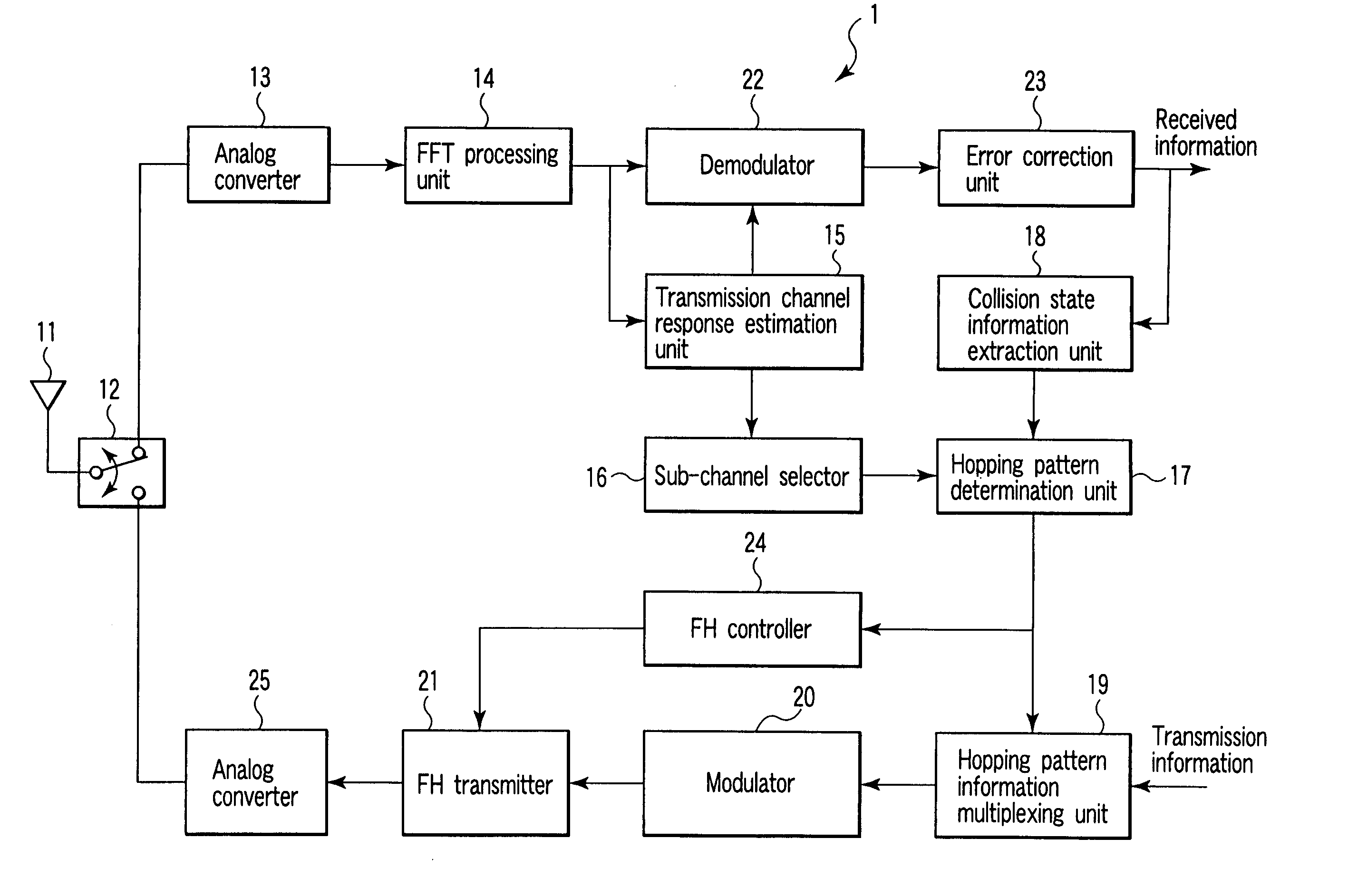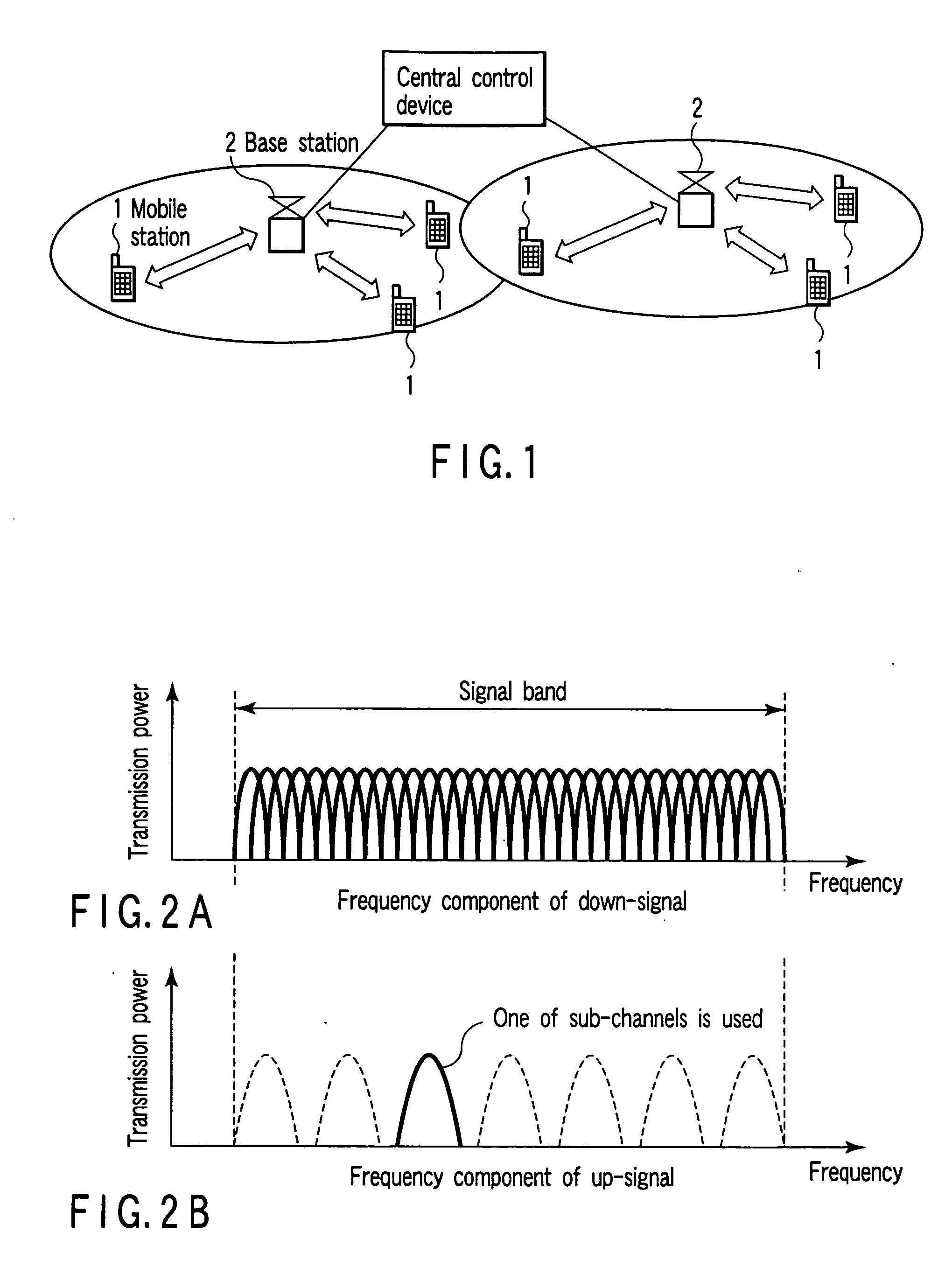Radio communication apparatus, base station and system
a radio communication and base station technology, applied in the direction of multiplex communication, wireless communication, orthogonal multiplex, etc., can solve the problem of difficult suppression of the occurrence itself of interference, weak possibility of transmission error, and inability to acquire information concerning the entire band of transmission signals of the base station at a tim
- Summary
- Abstract
- Description
- Claims
- Application Information
AI Technical Summary
Benefits of technology
Problems solved by technology
Method used
Image
Examples
first embodiment
[0073] Referring to the block diagram of FIG. 5, a description will be given of a radio communication apparatus (mobile station 1) according to a first embodiment.
[0074] The mobile station 1 of this embodiment determines a frequency-hopping pattern from sub-channels of a good propagation environment based on a signal supplied from the base station 2, and performs transmission using the determined frequency-hopping pattern. The mobile station 1 comprises an OFDM receiver and HF transmitter. As shown in FIG. 5, the mobile station 1 comprises an antenna 11, antenna duplexer 12, analog converter 13, FFT (fast Fourier transform) processing unit 14, transmission channel response estimation unit 15, sub-channel selector 16, hopping pattern determination unit 17, collision state information extraction unit 18, hopping pattern information multiplexing unit 19, modulator 20, FH transmitter 21, demodulator 22, error correction unit 23, FH controller 24 and analog converter 25.
[0075] The ante...
second embodiment
[0111] Referring now to FIG. 12, a description will be given of a radio communication apparatus (mobile station 1) according to a second embodiment of the invention.
[0112] The mobile station 1 of the second embodiment selects sub-channels of a good propagation environment based on a signal from the base station 2, and transmits the selected sub-channels to the base station 2. The base station 2 determines the respective frequency-hopping patterns of the mobile stations 1 based on sub-channels of a good propagation environment. Using the determined frequency-hopping patterns, the mobile stations 1 perform FH-scheme communication.
[0113] The mobile station 1 of the second embodiment differs from that of the first embodiment in that in the second embodiment, each mobile station 1 does not determine a frequency-hopping pattern, and performs FH-scheme communication based on hopping pattern information supplied from the base station 2. In the first and second embodiments, like reference ...
third embodiment
[0136] Referring to FIG. 16, a radio communication apparatus (mobile station 1) according to a third embodiment will be described.
[0137] The mobile station 1 according to the third embodiment detects a frequency-hopping pattern used by another mobile station 1, thereby determining a frequency-hopping pattern formed of sub-channels that are not incorporated in the detected frequency-hopping pattern.
[0138] The third embodiment differs from the first embodiment wherein the base station detects the collision state of frequency-hopping patterns. That is, in the third embodiment, each mobile station 1 detects the frequency-hopping pattern of another mobile station 1, thereby finding out unused sub-channels and incorporating the unused sub-channels in a frequency-hopping pattern. In the first and third embodiments, like reference numerals denote like elements, and duplication of explanation will be avoided. The mobile station 1 of the third embodiment employs a power-measuring unit 61 in...
PUM
 Login to View More
Login to View More Abstract
Description
Claims
Application Information
 Login to View More
Login to View More - R&D
- Intellectual Property
- Life Sciences
- Materials
- Tech Scout
- Unparalleled Data Quality
- Higher Quality Content
- 60% Fewer Hallucinations
Browse by: Latest US Patents, China's latest patents, Technical Efficacy Thesaurus, Application Domain, Technology Topic, Popular Technical Reports.
© 2025 PatSnap. All rights reserved.Legal|Privacy policy|Modern Slavery Act Transparency Statement|Sitemap|About US| Contact US: help@patsnap.com



